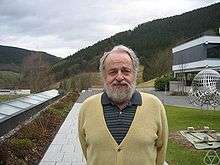John Friedlander
John Friedlander FRSC is a Canadian mathematician specializing in analytic number theory. He received his B.Sc. from the University of Toronto in 1965, an M.A. from the University of Waterloo in 1966, and a Ph.D. from Pennsylvania State University in 1972. He was a lecturer at M.I.T. in 1974-76, and has been on the faculty of the University of Toronto since 1977, where he served as Chair during 1987-91. He has also spent several years at the Institute for Advanced Study. In addition to his individual work, he has been notable for his collaborations with other well-known number theorists, including Enrico Bombieri, William Duke, Andrew Granville, and especially Henryk Iwaniec.
John Benjamin Friedlander | |
|---|---|
 John Friedlander in 2008 | |
| Citizenship | Canadian |
| Alma mater | University of Toronto, University of Waterloo, Pennsylvania State University |
| Known for | Analytic number theory Bombieri–Friedlander–Iwaniec theorem |
| Awards | Fellow of the Royal Society of Canada, Jeffery–Williams Prize, Fellow of American Mathematical Society, 2012 |
| Scientific career | |
| Fields | Mathematician |
| Institutions | Institute for Advanced Study MIT University of Toronto |
| Doctoral advisor | Sarvadaman Chowla |
| Doctoral students | Cem Yıldırım |
In 1997, in joint work with Henryk Iwaniec, Friedlander proved that infinitely many prime numbers can be obtained as the sum of a square and fourth power: a2 + b4.[1][2] Friedlander and Iwaniec improved Enrico Bombieri's "asymptotic sieve" technique to construct their proof.[3]
Awards and honors
In 1999, Friedlander received the Jeffery–Williams Prize.
In 1988, Friedlander became a fellow of the Royal Society of Canada.[4]
In 2002, CRM-Fields-PIMS prize
In 2012 he became a fellow of the American Mathematical Society.[5]
In 2017 he received the Joseph L. Doob prize, jointly with Henryk Iwaniec, for their book Opera de Cribro.
Selected publications
- Friedlander, John; Iwaniec, Henryk (2010). Opera de Cribro. Providence: American Mathematical Society. ISBN 978-0-8218-4970-5.
References
- Friedlander, John; Iwaniec, Henryk (1998). "The polynomial X2 + Y4 captures its primes" (PDF). Annals of Mathematics. Annals of Mathematics. 148 (3): 945–1040. arXiv:math/9811185. doi:10.2307/121034. JSTOR 121034.
- Friedlander, John; Iwaniec, Henryk (1997). "Using a parity-sensitive sieve to count prime values of a polynomial". PNAS. 94 (4): 1054–1058. Bibcode:1997PNAS...94.1054F. doi:10.1073/pnas.94.4.1054. PMC 19742. PMID 11038598..
- International Team Shows that Primes Can Be Found in Surprising Places
- Search Royal Society of Canada Fellows, retrieved 2013-01-2013.
- List of Fellows of the American Mathematical Society, retrieved 2012-12-29.
External links
- John Friedlander at the Mathematics Genealogy Project
- John Friedlander's profile in Toronto's Focus on Research.
- On Bombieri's asymptotic sieve